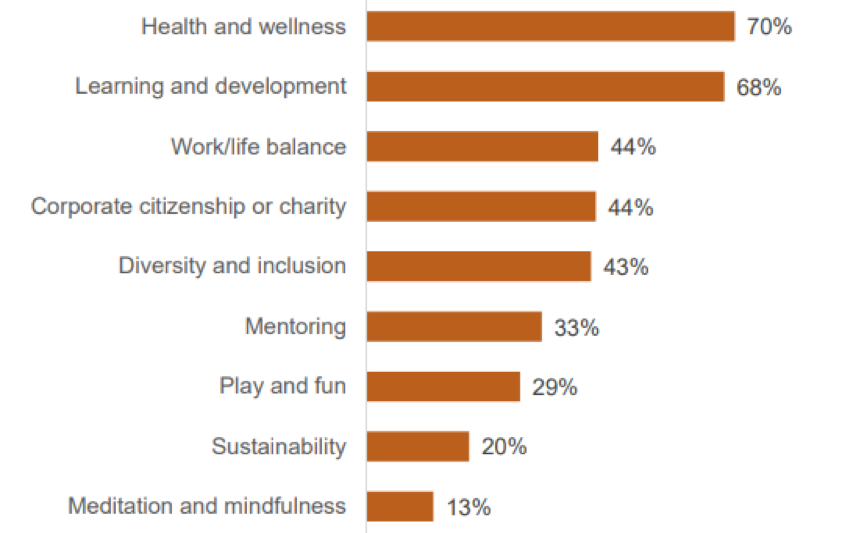Today’s employees expect improved experiences from their work environments/culture to stay engaged in their workplaces. Companies are recognizing that, with today’s low rate of unemployment, people have choices of where they can use their skills.
To vie for the most adept in the workforce, and to retain top talent, more companies are beginning to care for their people by offering extra advantages, such as free lunches or daycare. They’re offering a la carte options, such as time, monetary, and non-monetary extras, for a tailored approach.
WHAT IS ORGANIZATIONAL CULTURE?
Jim Rowell, Rising Sun Consultants, LLC, defines Organizational Culture as “agreed-upon norms and experiences of how employees interact with each other on a daily basis.”
It is a company’s work environment – the way it actually feels to work at a company, and not necessarily what is written and handed to a new employee by HR on their first day.
A company’s organizational culture is what drives employees’ behavior. Does the company allow (or expect) an employee to eat their lunch at their desk in order to keep working, or does the company stress taking a break to clear their heads?
ATMOSPHERE OR ATMOS-FEAR?
There’s been an interesting blending of personal and professional time. Thanks to technology, work doesn’t have a distinct stop time anymore.
– SHRM CEO Johnny C. Taylor, Jr.
The unwritten rule is a real organizational culture. Are employees encouraged to quietly fix a mistake? “Fix it and don’t say anything” is an atmosphere of fear. Or is it one of transparency where, although it may be embarrassing, they know they can and should talk to their supervisor, to make them aware of an error, for the purpose of working it out together?
SO WHAT IS BEING OFFERED TO EMPLOYEES TO CREATE AN ATTRACTIVE CULTURE?
In SHRM’s January 2018 Report: “Using Recognition and Other Workplace Efforts to Engage Employees,” some highlighted programs offered to enhance organizational culture include:

The percentages in the above graph represent what HR professionals agree are most effective to offer and engage employees.
WHAT IS EMPLOYEE ENGAGEMENT?
Rowell explains, “the number one factor or contributor to an employee’s engagement is their direct relationship with their supervisor.”
Morag Lucey, Forbes Magazine, defines it as “the state of emotional and intellectual commitment to a company that leads to discretionary effort – employees going above and beyond minimum requirements… They believe and connect with company mission… It is the degree to which we have captured the hearts and minds of employees.”
Lucey further suggests that Millennials, who make up 56% of the working population in the US, are concerned with social awareness and purpose in their work. They seek out companies that are in line with that way of thinking.
WHO’S LEADING THE WAY?
Two companies stand out and reign supreme in the area of company culture, and lead Fortune’s Best Places to Work.
HILTON
Fortune’s 2019 list of “100 Best Companies to Work For” ranked Hilton number one. Hilton is known as the world’s most hospitable company recognized for its workplace culture. Hilton’s team members claim that its “culture, benefits and travel perks make it a great place to work.”
Among Hilton’s Thrive perks are growth opportunities and family-friendly benefits: expanded parental leave, adoption assistance, bereavement leave, access to Milk Stork, paid time off, and Go Hilton rates.
Hilton provides a flexible ecosystem: flexible work environment, innovative Learning and Development, and volunteer opportunities. Their programs are often a result of employee feedback, and they offer all the perks to both salaried and hourly employees.
SALESFORCE
Ranked number two is Salesforce. Management focuses on being highly intentional about providing a great work environment. They meticulously measure employee satisfaction and overall communication. An example of how they offer a great work environment: in most of their buildings, the top floor dons an Ohana (meaning “family”) suite, a hang-out decorated with a modern feel, with couches and throw pillows.
Their culture formula is culture + technology + data = Employee Engagement.
They boast, “we devote a significant amount of time and resources to defining our culture, hiring people who align with it, immersing new employees in it, and living and breathing it — inside and outside Salesforce.”
WHAT CAN YOUR COMPANY DO?
An employee reporting a good experience, and who feels taken care of by their company, is most likely to engage in, and sometimes defend, the company they work for and its culture.
To answer the workforce, companies have started shifting their policies and offers to meet the needs of the newer, tech-savvy population. Nowadays, if companies are not offering added creative, time, monetary, and non-monetary advantages, they may not be able to attract or retain top talent. Companies must be intentional about keeping up with this alteration in the workforce.

